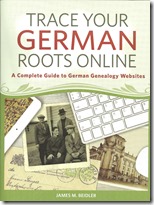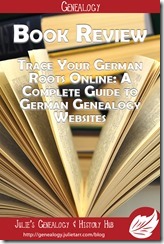 Title: Trace Your German Roots Online: A Complete Guide to German Genealogy Websites
Title: Trace Your German Roots Online: A Complete Guide to German Genealogy Websites
Author: James M. Beidler
Format: Paperback, Kindle
Published: 2016
My Rating: ![]()
![]()
![]()
![]()
The following review first appeared in the Federation of Genealogical Societies FORUM magazine (Winter 2016); reprinted with permission.
Trace Your German Roots Online: A Complete Guide to German Genealogy Websites by James M. Beidler can be considered a companion to Beidler’s earlier book The Family Tree German Genealogy Guide: How To Trace Your Germanic Ancestry in Europe (Family Tree Books, 2014). While there are a few bits and pieces that carry over from the earlier book, Trace Your German Roots Online consists of fresh content that focuses mainly on using the Internet to find German-speaking ancestors. And we’re not just talking about websites that hold indexes, databases, and digital images—Beidler also discusses several websites and online tools that provide general reference materials, help with reading old German handwriting, aid in translations, and assist in finding German villages.
In part 1, “German Genealogy Basics,” Beidler supplies an overview of things researchers will need to know in order to be successful in researching German ancestors. This includes things such as research techniques, political and ecclesiastical history, how to identify origin, and understanding the German language. Several websites and online tools are discussed in chapters 2 and 3 ranging from dictionaries (including one that helps with archaic words) to maps and gazetteers. Beidler provides several lists of resources including one for learning the language and one for understanding old German letter styles. Although this part is small, compared to parts 2 and 3, there is a lot of great information among these pages and it should not be overlooked.
Beidler gets to the heart of the book in part 2, where he highlights several websites that are helpful for those researching their German roots. Readers will find an in-depth discussion for each website, along with step-by-step examples that contain corresponding illustrations. Before reading this book, I was already familiar with (and had used) all of the websites. However, I learned several new things, especially concerning the German website Genealogy.net that I can’t wait to explore further. There are five major websites covered in part 2: FamilySearch, Ancestry, Genealogy.net, MyHeritage, and Archion.
“Answers to Your Research Questions” is the title of part 3, and readers may wonder what this has to do with a book about online German resources. In a word—everything. Among these pages readers will find those one-off websites and tools; that is, the smaller, lesser-known resources beyond the “biggies” discussed in part 2. Want to know what Ortssippenbuch, Ortsfamilienbuch, or Dorfbuch are and where to find them online? Readers will find the answer in chapter 9. Also in chapter 9 are tons of websites related to emigration/immigration. Part 3 also provides advice and online resources for contacting possible relatives, professional researchers, and repositories in Germany. Readers will also find online digital archival collections, online German newspapers, and several miscellaneous items in this part. There is even a discussion on using social media as a tool for German genealogy research.
Rounding out this book are two appendixes and an index. The first appendix contains a handful of maps, including one identifying Catholic dioceses in modern Germany and one representing Germany after unification in 1871. The second appendix is a listing of all the websites and online tools that are mentioned in the book. It is divided into categories and indicates the language of the website and in which chapter the details of the website can be found.
The only disappointment with this book is the same one I encountered in the earlier book The Family Tree German Genealogy Guide—the coverage of places that are not in present-day Germany is lacking. There are many online resources that cover these areas, such as parts of Prussia now in Poland. Although such resources aren’t highlighted, readers can use the information in the book to get ideas for seeking out similar resources in the area of interest. This strategy also applies to other resources not mentioned in the book (we can’t always be exhaustive) and for resources that come online in the future.
Overall, Trace Your German Roots Online covers a lot of resources and each is explained well. Readers can expect to find a good deal of helpful websites and online tools including: translation tools, maps, databases and indexes, digital records and books, and general reference materials. Those new to German genealogy would benefit from reading Beidler’s earlier book The Family Tree German Genealogy Guide (mentioned earlier) before diving into Trace Your German Roots Online. But regardless of experience level, those who pick up this book are bound to find many things that will be useful in their German genealogy quest.



Share your thoughts...